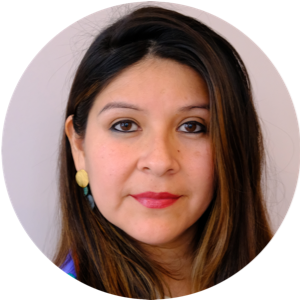
On Day 5, we will be interacting in our third and last virtual session on Zoom. We encourage you to complete the following readings and activities, and come to the virtual session with your reflections on Community Engagement, Dialogue and Training.
Part of the session will be facilitated in Spanish with simultaneous English translation. Participants can interact in the language of their choice (English or Spanish).
June 11 or 18 from 8:30AM to 11:30AM (AST)
Facilitators

Dr Alexandra Carlier is a specialist in water governance and Integrated Water Resources Management from a gender and intercultural perspective, with experience in articulating intergovernmental, institutional and civil society stakeholders.

Mauricio Cerna has expertise in soft-skills training for government and local communities, and gender approach related to water and climate change issues. He is a consultant on water governance, adaptation to climate change and social conflicts related to water management.
Session’s Agenda
| Programme | June 11th or 18th, 2021 |
|---|---|
| 8:30-8:35 | Welcoming remarks and rules of engagement |
| 8:35-8:40 | Session’s objectives |
| 8:40-8:55 | How do we communicate? |
| 8:55-9:15 | What we communicate: information, emotions, and perceptions |
| 9:15-9:30 | What are our experiences? |
| 9:30-9:45 | Coffee break |
| 9:45-10:15 | How to communicate and engage? Techniques to build key messages for specific audiences |
| 10:15-11:20 | Knowledge dialogue |
| 11:20-11:25 | Closing remarks |
| 11:25-11:30 | 5-day programme conclusion and evaluation (SurveyMonkey) |
You can complete the following activity on your Phone. You do not need to install the Padlet app, click the following link and complete the activity: https://padlet.com/manueldias30/8rlg5l8k3sf9k2t1
Activity: Padlet
Before we start module 5, we would like to ask you to do a small homework using a Padlet.
For this exercise, share one, two or three photographs of places and situations where water is wasted by citizens, or because of infrastructure failures. It can be a current photograph in your neighbourhood or a photograph you took during a previous field trip.
Then write down the story of the photograph in a post on Padlet, and what you think and feel when you see such situations.
Instructions: How to contribute to this Padlet?
How to contribute to this Padlet (click to expand)
You can complete this activity on your phone.
- Click the pink + button on the right-hand side corner of your screen;

- In Search a place by name, enter your country and select it from the list in the drop-down menu.

- Click the upload option to upload your image.
- Click the three-dotted button to access more advanced options (i.e. video recorder, location, drawing, etc.)

- Write your answer and click Save.
- Click the minus button on the left hand-side of your screen to zoom out and locate your post in the Caribbean region.
- Double tap on your entry to edit it.
- Click the pink + button to post another photo.
Introduction
Dialogue and participation are two dimensions of water governance, which are central to fostering Integrated Water Resources Management (IWRM) in a context of climate change. Through them, trust between water users, managers and technicians is increased, joint decisions are fostered, the risk of conflicts is reduced, and the resilience of communities and water infrastructure is enhanced. In order for this to happen, dialogue and participation require strengthening the soft skills of officials and collaborators in the water sector.
This module presents concepts and techniques aimed at improving the soft skills required to ensure that dialogue with communities and their participation in water and resilience issues is sustainable and oriented towards cooperation around water resources and building community resilience. In this sense, it generates capacities for the implementation of concepts, suggestions and technical procedures presented in the previous modules.
Objectives
Upon completion of this module, you will be able to:
- Differentiate the concepts of water governance, dialogue and participation around water resources, in the context of climate change and international instruments for action;
- Foster dialogue and participation processes for Integrated Water Resources Management resilient to climate change;
- Strengthen communication and engagement between your institutions and local communities;
- Identify, make visible and promote the contributions of local communities in the face of climate change.
To know in this Module
- Concepts to promote community involvement in IWRM: soft skills, water governance, dialogue, and community participation.
- International frameworks for community participation in natural resource management and sustainable development in the context of climate change: Paris Agreement, Sendai Framework, Convention on Biological Diversity and ILO Convention 169.
- Communication and local community relationship management: types of communication, techniques for dialogue and efficient communication (one liner, rule of three, list, comparison, metaphor and question) and dialogue of knowledge.
To-Do in this Module
| Type | Duration |
|---|---|
| Local communities as subjects of knowledge | 15 min |
| Water governance | 15 min |
| Communication at community level | 20 min |
| Dialogue of knowledge | 10 min |
Key concepts: local knowledge, water governance, soft skills, participation, dialogue, effective communication and dialogue of knowledge.
1. Local communities as subjects of knowledge
The problems generated by climate change have led in recent years to greater recognition, appreciation and promotion of the knowledge of communities vulnerable to climate change, within the framework of the adaptation and resilience-building agenda. This has been possible because the international scientific community, international policy instruments and civil society have begun to recognise communities (local and indigenous) as subjects or collective protagonists with relevant knowledge and capacities (IPCC, 2017). In this sense, the formulation of proposals for adaptation to climate change is increasingly participatory and multidisciplinary, as they are the result of dialogue between different areas of knowledge, including community knowledge related to natural resources, climate and weather (Lemos and Morehouse, 2005). This implies that community participation is becoming relevant, to the extent that it is acknowledged in various international policy documents.
1.1. Rationale for the participation and recognition of local and indigenous knowledge in international policy instruments
At the international level, the participation of local communities in the production of knowledge relevant to natural resource management and climate change adaptation is endorsed by various public policy instruments. These not only suggest that communities should be involved and valued in the formulation of policy-driven initiatives, they also suggest that they have a role in knowledge building.
Furthermore, they do not present communities as a homogenous reality. They recognise that there are localities or indigenous groups among them, whose knowledge is relevant to the climate, risk reduction and biodiversity agendas, among others.
Central considerations on participation and local knowledge in the climate, natural resources and risk management agenda.
The Convention on Biological Diversity (click to expand)
Article 8: In-situ conservation(j) Subject to its national legislation, respect, preserve and maintain knowledge, innovations and practices of indigenous and local communities embodying traditional lifestyles relevant for the conservation and sustainable use of biological diversity and promote their wider application with the approval and involvement of the holders of such knowledge, innovations and practices and encourage the equitable sharing of the benefits arising from the utilization of such knowledge, innovations and practices”
Article 14. Impact Assessment and Minimizing Adverse Impacts1. Each Contracting Party, as far as possible and as appropriate, shall:
(a) Introduce appropriate procedures requiring environmental impact assessment of its proposed projects that are likely to have significant adverse effects on biological diversity with a view to avoiding or minimizing such effects and, where appropriate, allow for public participation in such procedures;
Article 17. Exchange of Information1. The Contracting Parties shall facilitate the exchange of information, from all publicly available sources, relevant to the conservation and sustainable use of biological diversity, taking into account the special needs of developing countries.
2. Such exchange of information shall include exchange of results of technical, scientific and socio-economic research, as well as information on training and surveying programmes, specialized knowledge, indigenous and traditional knowledge as such and in combination with the technologies referred to in Article 16, paragraph 1 […].
The Paris Agreement (click to expand)
Article 12Article 12 “Parties shall cooperate in taking measures, as appropriate, to enhance climate change education, training, public awareness, public participation and public access to information, recognizing the importance of these steps with respect to enhancing actions under this Agreement”.
Article 7.5. states: “Parties acknowledge that adaptation action should follow a country-driven, gender-responsive, participatory and fully transparent approach, taking into consideration vulnerable groups, communities and ecosystems, and should be based on and guided by the best available science and, as appropriate, traditional knowledge, knowledge of indigenous peoples and local knowledge systems, with a view to integrating adaptation into relevant socioeconomic and environmental policies and actions, where appropriate”.
The Sendai Framework for Action (click to expand)
Guiding Principles:(g) Disaster risk reduction requires a multi-hazard approach and inclusive risk-informed decision-making based on the open exchange and dissemination of disaggregated data, including by sex, age and disability, as well as on easily accessible, up-to-date, comprehensible, science-based, non-sensitive risk information, complemented by traditional knowledge;
Priority 1. Understanding disaster risk(i) To ensure the use of traditional, indigenous and local knowledge and practices, as appropriate, to complement scientific knowledge in disaster risk assessment and the development and implementation of policies, strategies, plans and programmes of specific sectors, with a cross-sectoral approach, which should be tailored to localities and to the context;
Role of stakeholders(iv) Older persons have years of knowledge, skills and wisdom, which are invaluable assets to reduce disaster risk, and they should be included in the design of policies, plans and mechanisms, including for early warning;
(v) Indigenous peoples, through their experience and traditional knowledge, provide an important contribution to the development and implementation of plans and mechanisms, including for early warning;
A problem that is often discussed when mentioning community knowledge is that it is presented in a general way, when in reality the type of knowledge and contribution to co-production of knowledge for climate change adaptation may vary according to age, culture and gender. In this context, one of the challenges is to make women and their contributions visible as members of the communities or localities.
The recognition of community knowledge and its incorporation into national policies and technical instruments must be gender-sensitive. In other words, it must ensure that women and men are recognised as people with equal capacities, opportunities and rights, as well as closing gender gaps, disparities and barriers.
| Table 1. | Definitions of Gender Gaps, Inequalities and Barriers Source: UN-WOMEN (2019). Guidance note. Gender mainstreaming, principles, dimensions and priorities for PVE. |
|---|---|
| Gender gaps | Unequal patterns of access, participation and control of women and men over resources, services, opportunities and benefits of development. They can be structural or gendered and have the capacity to reinforce unequal power relations between women and men or between groups. |
| Gender inequalities | Unfair and avoidable gender-based situations. For example, violence against women, which is based on a situation of subordination and underestimation by men and the sex-gender system, creates a major problem for the victims themselves and for society as a whole. |
| Gender barriers | These are aspects that have an impact on the problem and can affect possible solutions to it. These limitations and barriers can be understood as a set of values, beliefs, expectations, norms, distribution of power and prestige in the relations between men and women. |
https://www.unwomen.org/en/digital-library/publications/2019/09/gender-mainstreaming-principles-dimensions-and-priorities-for-pve
1.2. What is local and indigenous knowledge?
“Local and indigenous knowledge are the knowledges, skills and philosophies developed by societies with a long history of interaction with their natural environment”.
(UNESCO 2002, p.8)
Although not all local knowledge is indigenous knowledge, it refers to the knowledge that citizens have and develop over time as part of their experience. It therefore contributes to local decision-making and guides everyday life. This is why they play an important role in climate change adaptation processes, vulnerability reduction and resilience building.
| Table 2. Local and indigenous knowledge for adaptation, scenario analysis, vulnerability reduction and resilience building. Source: UNESCO (2002). Local Knowledge, Global Goals. Pp. 25.31 |
|---|
| “Adaptive knowledge for variability and change. The knowledge of Indigenous peoples is not a static body of ‘traditional” information. Indigenous peoples have always been confronted with environmental variability, unpredictability and change. Their knowledge is thus a dynamic system that is collectively and continuously re-visited, re-shaped and shared across a web of social actors. It maintains its adaptive capacity and vitality. In this sense, indigenous knowledge bears a resemblance to science. Science defines itself by the scientific method and not as a fixed body of data, as this would inevitably become outdated. While acknowledging the wisdom of their elders, indigenous knowledge holders emphasise the central role of their own learnings and experiences. In this manner, successive generations adapt and transform their understandings in the face of environmental variability and change”. “Community-based assessments of global climate changes. Observation and interpretation of meteorological phenomena have guided the activities of local communities for millennia. Planting and harvesting, transhumance or herd migration, and the timing and locations of hunting, fishing or gathering are dependent on detailed understandings of weather and climate”. “Vulnerability and resilience in a world of change. Indigenous peoples and marginalised populations are particularly exposed and sensitive to climate change impacts due to their resource-based livelihoods and homelands in marginal environments. Small population size, isolation, and the absence of recognised rights over resources contribute to their vulnerability to economic, social and environmental impacts that are exacerbated by climate change. Despite their high exposure and sensitivity, Indigenous peoples and local communities are actively responding to climate change, showing great resourcefulness. Adaptation is rooted in local knowledge, social systems, and cultural values and attitudes. Strategies include maintaining genetic and species diversity in crops and herds, mobility, diversified use of landscapes, and livelihoods based on use of multiple resources. Traditional systems of governance and social networks reinforce the ability to respond collectively to change and build resilience”. |
For the work of water sector organisations, local and indigenous knowledge are sources for the creation and implementation of instruments such as norms, action guidelines, protocols and projects. Recognising this implies that water sector institutions acknowledge that communities are not passive agents, but development actors with knowledge that must be identified, valued and included in decision-making.
